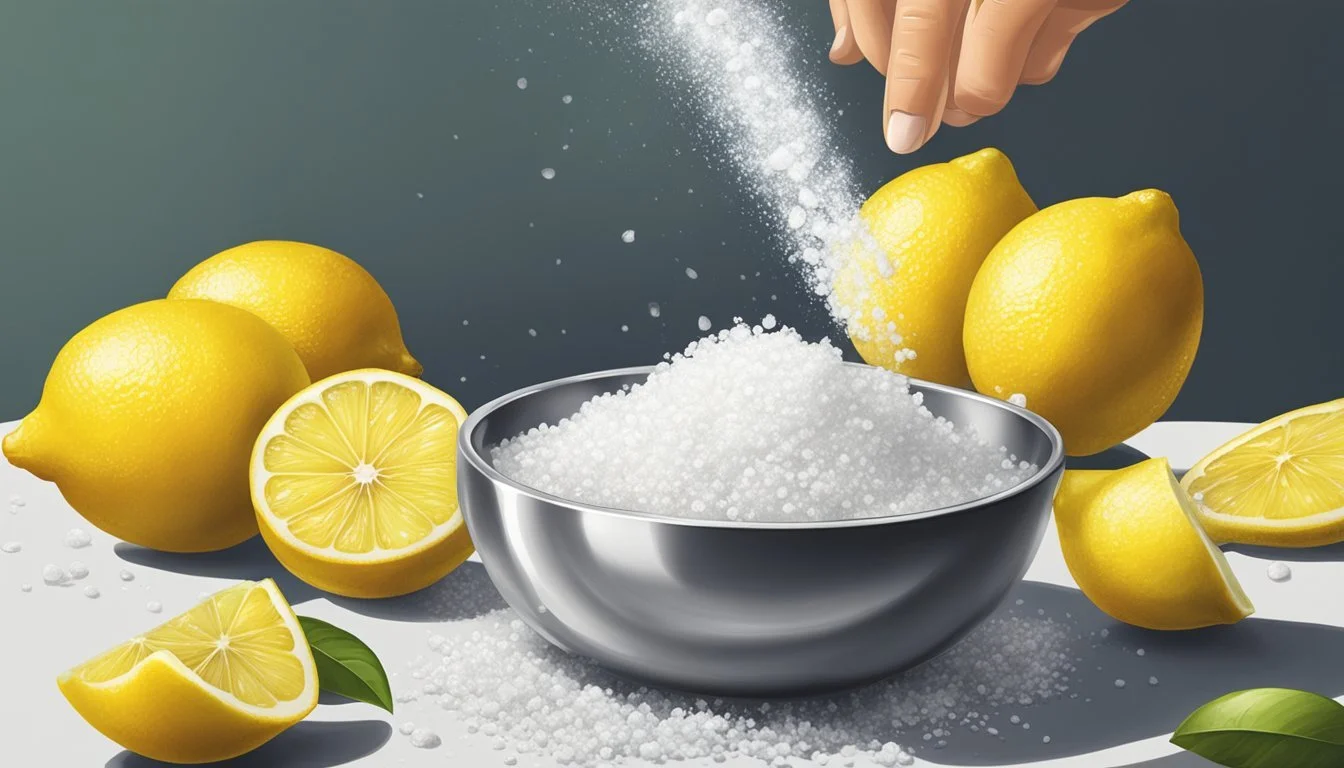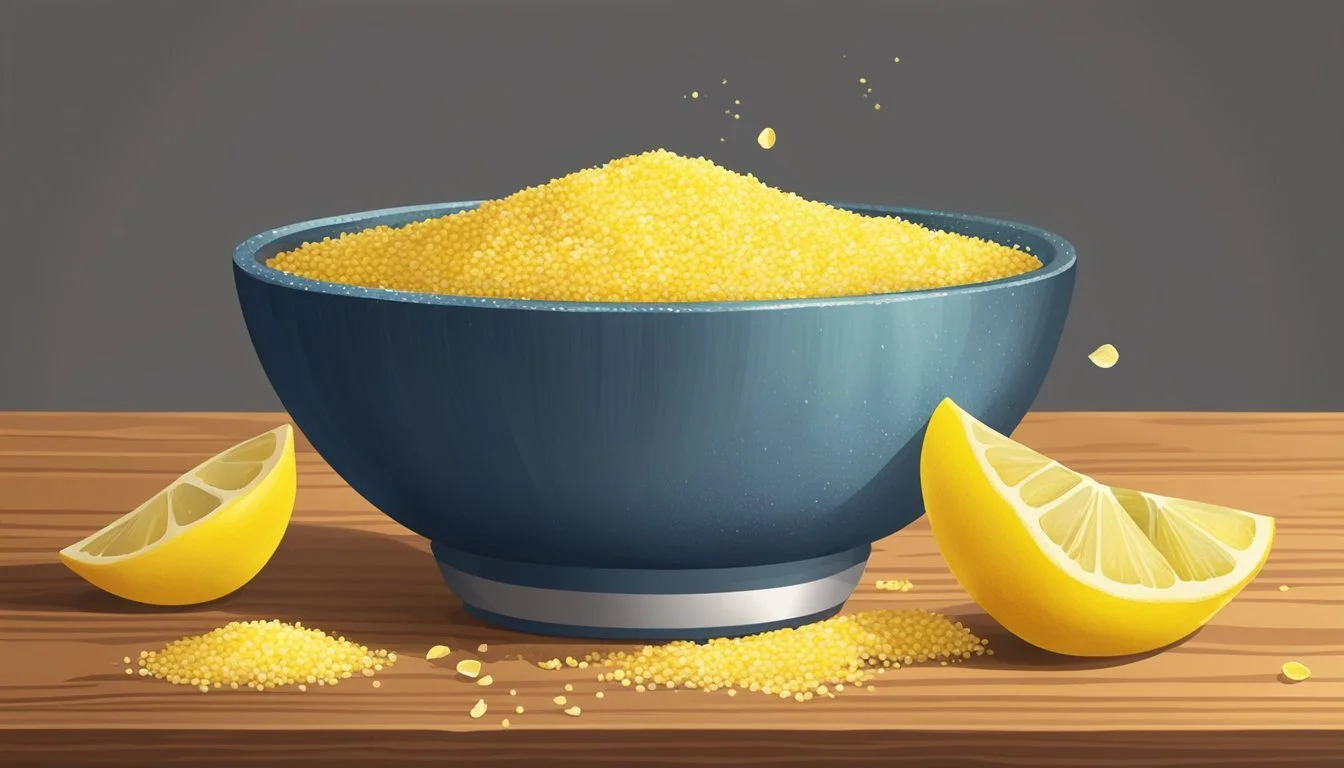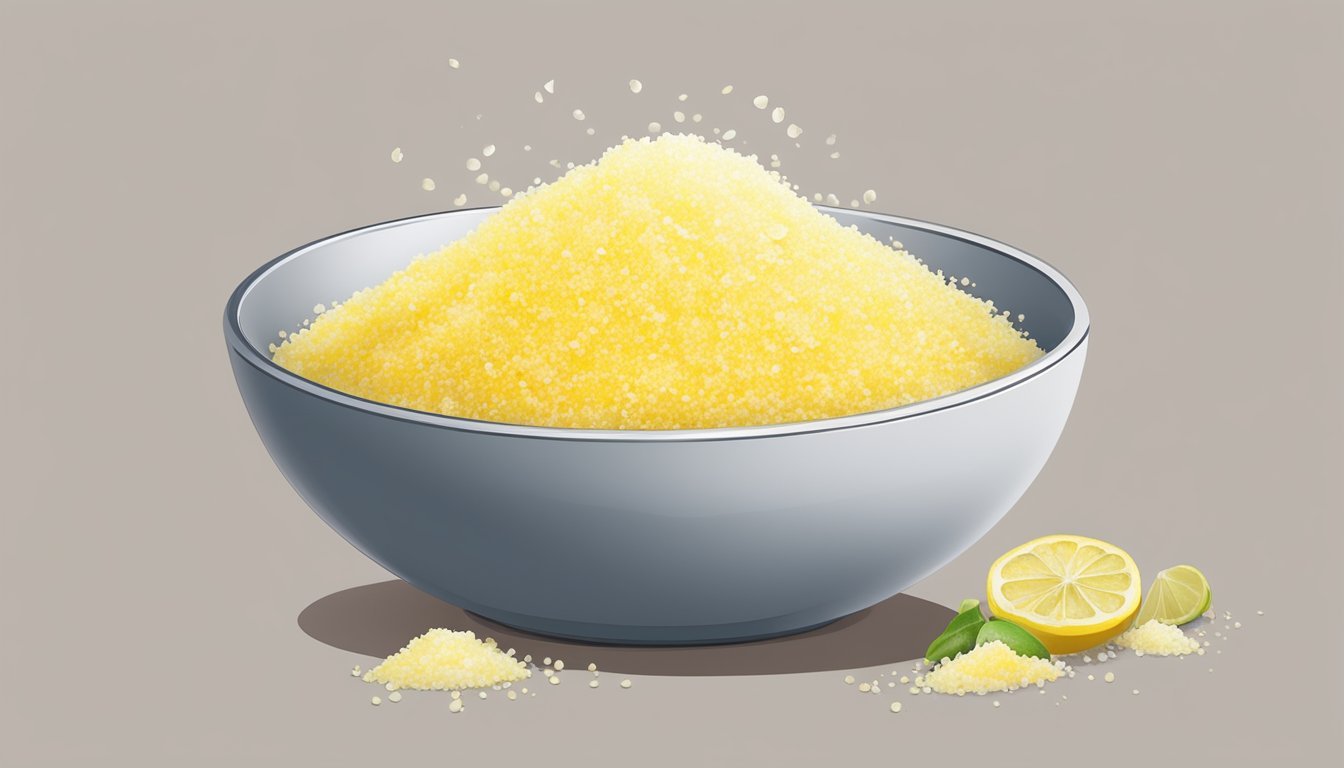Lemon Peel Salt
The Zesty Secret to Elevating Your Dishes
Lemon peel salt is a zesty, citrusy seasoning that brings a fresh and flavorful twist to an array of dishes. This pantry staple combines the invigorating essence of lemon zest with the foundational taste of salt, enhancing foods with a bright and tangy accent. A versatile ingredient, it easily mingles with a variety of seasoning blends, adding a new dimension to traditional recipes.
The beauty of lemon peel salt lies in its simplicity and the depth of flavor it provides. Crafted from dried lemon peels and coarse or fine salt, this seasoning captures the natural oils and fragrant notes of citrus, making it an excellent addition to marinades, rubs, and even as a finishing touch on desserts.
Seasoning blends inclusive of lemon peel salt often incorporate other citrus elements such as orange or grapefruit zests, honey powder, or citrus powders, which augment its zesty character. It's not uncommon to find it paired with complementary herbs and spices like garlic, onion, parsley, and nutmeg, allowing cooks to experiment and elevate their culinary creations with just a sprinkle.
What Is Lemon Peel Salt?
Lemon peel salt is a seasoning blend that infuses the sharp, tangy zest of lemon peels with salt, creating a bright and zesty flavor enhancer for a variety of dishes.
Origins and Popularity
Lemon peel salt has its roots in culinary traditions that value the use of the whole fruit. By utilizing the vibrant zest from lemon peel, this seasoning maximizes flavor while minimizing waste. Its popularity has grown due to its ability to add a burst of citrusy brightness to foods without the added acidity that comes from the juice itself.
Lemon Peel Salt vs. Lemon Pepper Seasoning
While both lemon peel salt and lemon pepper seasoning combine zesty citrus flavors with a savory base, their applications and ingredient profiles differ. Lemon peel salt is primarily a mixture of lemon peel and salt that lends a tangy flavor to dishes. On the other hand, lemon pepper seasoning often includes black pepper or other spices, providing a more complex flavor that is both zesty and spicy. Lemon pepper seasoning may also contain additional elements like garlic or onion powder for depth.
Health Benefits
Lemon peel salt is not just a flavor enhancer; it also brings a host of health benefits due to its nutritional composition and potential role in sodium intake moderation.
Nutritional Components
Lemon peels are rich in essential nutrients. When utilized in making lemon peel salt, they contribute the following key components:
Vitamin C: An antioxidant essential for collagen synthesis, immune function, and skin health.
Potassium: Supports nerve function and is vital for muscle contractions and heart health.
Calcium: Crucial for bone health and plays a role in heart and muscle function.
Iron: Necessary for making hemoglobin, the protein needed to transport oxygen in the blood.
These nutrients are intrinsic to maintaining overall well-being. However, the actual nutritional value of lemon peel salt can vary based on the proportion of lemon peel to salt and the amount of seasoning used in dishes.
Sodium Reduction and Balance
Replacing regular table salt with lemon peel salt can contribute to a better sodium-potassium balance which is crucial for cardiovascular health. Here is a comparison of standard table salt and lemon peel salt:
Table Salt (Sodium Chloride) Lemon Peel Salt Sodium Content High Reduced* Flavor Profile Salty Citrus-infused
*Note: The reduction in sodium depends on the ratio of lemon peel to salt.
By substituting plain salt with lemon peel salt, individuals may reduce their overall sodium intake while still enjoying the savory essence that salt provides. Reduced sodium helps in lowering blood pressure and the risk of heart disease. Moreover, lemon peel salt offers a flavorful alternative without compromising on taste.
Consumption of calories remains minimal with lemon peel salt as it is used sparingly like any other seasoning. However, it's important to remember that while lemon peel salt can contribute to nutritional intake, it should be used within the context of a balanced diet.
Making Lemon Peel Salt at Home
Creating lemon peel salt at home is straightforward, requiring only a few ingredients and simple steps. Home cooks can achieve a bright, citrusy seasoning perfect for elevating various dishes.
Required Ingredients
Lemon zest: From 2-3 fresh lemons
Sea salt: 1 cup
Garlic powder: 1 teaspoon (optional)
Onion powder: 1 teaspoon (optional)
Step-by-Step Guide
Preheat the oven to 200 degrees Fahrenheit to dry the lemon zest, ensuring it blends smoothly with the sea salt.
Zest 2-3 lemons, making sure to avoid the bitter white pith.
Combine the lemon zest and sea salt evenly on a baking sheet lined with foil.
Bake in the preheated oven until the lemon zest is completely dry, typically for about 20-25 minutes, stirring occasionally.
Cool the mixture, then transfer to a spice grinder or use a mortar and pestle to achieve the desired texture.
Store the lemon peel salt in an airtight container to maintain its freshness.
Adding Extra Flavors
For those looking to enhance their homemade lemon peel salt:
Add 1 teaspoon of garlic powder for a savory note.
Incorporate 1 teaspoon of onion powder for additional depth.
Blend these optional ingredients with the lemon zest and sea salt before the drying process for optimal flavor integration.
Culinary Uses of Lemon Peel Salt
Lemon peel salt adds a zesty twist to various dishes, infusing them with a bright, citrusy spark that accentuates the natural flavors of the ingredients it seasons.
Poultry and Meat
Lemon peel salt brings a fresh, tangy dimension to chicken and meat dishes. It works particularly well when sprinkled over chicken wings before grilling or baking in the oven. For lemon pepper chicken, one can rub the salt onto the skin to create a flavorful crust that enhances the juicy meat within.
Grilled meats: Elevate the taste by gently rubbing lemon peel salt on the surface before cooking.
Roast preparations: Sprinkle over meats to infuse a lemony note throughout the cooking process.
Seafood and Fish
The salt's bright flavor pairs wonderfully with the delicate taste of seafood and fish. It can be used to season fillets prior to grilling or to enhance the taste of fish when baking in the oven.
Grilled seafood: Apply a generous pinch before cooking to add depth to the flavors.
Fish dishes: Mix the salt into marinades or use as a finishing touch to lend your fish a subtle, citrusy undertone.
Vegetables and Salads
Roasted vegetables carry an enriched flavor profile when tossed with lemon peel salt. It also adds a refreshing twist to salads, complementing both the greens and the dressing.
Salads: Finish with a light dusting to tie the flavors together.
Vegetable sides: Combine with olive oil and coat vegetables before roasting.
Soups, Stews, and Sauces
Incorporating lemon peel salt into soups, stews, and sauces enhances both aroma and taste with its citrusy notes, providing a bright contrast to the richness of hearty dishes.
Soups and stews: Stir in towards the end of cooking to maintain the salt's vibrant flavor.
Sauces: Whisk a dash into pasta or rice sauces for a subtle, yet impactful, lemony zing.
Storing Your Lemon Peel Salt
Proper storage of lemon peel salt is crucial in maintaining its freshness and vibrant flavor. One should always opt for an airtight container to ensure that moisture is kept at bay, as excess humidity can cause clumping and reduce the quality of the seasoning. Plastic or glass containers with tight-sealing lids work well for this purpose.
When selecting a storage spot, a cool, dark place is ideal. A pantry or a kitchen cabinet away from direct sunlight and heat sources helps to preserve the potency of the lemon peel salt. Exposure to light and heat can diminish the aromatic oils and alter the zestful flavor profile that characterizes the salt.
Here are key points one should consider when storing lemon peel salt:
Airtightness: Ensure the container is sealed properly after each use.
Location: Choose an area with a stable temperature, away from the stove or oven.
Moisture-Free Environment: Avoid places where the salt might be exposed to steam or dampness.
Do's Don'ts Use an airtight container Store near moisture or heat sources Keep in a cool, dark location Leave the container open or not properly sealed Ensure the container is dry Expose to direct sunlight
By following these guidelines, the integrity of the salt's distinct citrusy tang is retained, ensuring it remains a delightful addition to your culinary creations.
Comparing Homemade and Store-Bought
When examining lemon peel salt, one must consider the differences in cost, flavor, and additive presence between store-bought and homemade versions.
Cost and Accessibility
Store-bought lemon peel salt is readily available in most supermarkets, but it can be more expensive when compared to making your own - especially if you already purchase lemons regularly. Homemade seasoning not only affords a budget-friendly option but also allows usage of existing kitchen resources.
Store-Bought: Typically ranges in price.
Homemade: Cost of lemons and salt, plus time investment.
Flavor Differences
The hallmark of homemade lemon peel salt lies in its freshness and potency. Store-bought varieties often lack the vibrant zest of freshly grated lemon peels, and some may be overly salty to compensate for this shortfall. Homemade batches, conversely, boast a brighter, more authentic citrus profile.
Store-Bought: Potentially muted citrus notes; uniform taste.
Homemade: Bright, fresh, customizable flavor intensity.
Presence of Additives
Commercially available lemon peel salts may contain additives to extend shelf life or enhance flow. Homemade versions, however, give an individual the power to create an organic and gluten-free seasoning, ensuring natural ingredients without unwanted extras.
Store-Bought: Preservatives and anti-caking agents possible.
Homemade: Pure ingredients; no additives.
Enhancing Recipes with Lemon Peel Salt
Lemon peel salt is a versatile addition to a well-stocked pantry, providing a bright and tangy flavor that complements a vast array of dishes. It can elevate the taste of marinades and dressings, and serve as an excellent finishing touch to cooked meals.
Marinades and Dressings
The zesty nature of lemon peel salt makes it an ideal component in marinades, imparting a citrusy depth to meats and vegetables. When herbs and spices are combined with lemon peel salt, they benefit from its ability to tenderize proteins while infusing them with its tangy essence.
In salad dressings, the inclusion of lemon peel salt not only seasons the mixture but also adds a note of brightness, enhancing the profiles of the salad's fresh ingredients. A simple vinaigrette can consist of:
Olive oil: 3 parts
Vinegar: 1 part
Lemon peel salt: To taste
Mix these ingredients well to distribute the flavors evenly, leading to a balanced and zesty dressing.
Finishing Touch
As a finishing touch, lemon peel salt can be sprinkled onto dishes just before serving to boost their flavor. It excels when dusted over:
Grilled vegetables, imparting a subtle, smoky and tangy note
Roasted meats (What wine goes well with roasted meats?) from the oven or grill, adding a fresh zestiness
Air-fried creations, to heighten the taste without additional fat or calories
Due to its potent flavor, chefs should use lemon peel salt sparingly to prevent overpowering the other flavors within the recipe. It effectively enhances the underlying taste of the primary ingredients, bringing them to the forefront with a citrusy flair.
Tips and Tricks for Perfect Lemon Peel Salt
When making Lemon Peel Salt, achieving the ideal texture and flavor balance is crucial. Drying the lemon peel properly ensures a rich zesty flavor, and the ratio of salt to lemon is key to a tasteful blend.
Getting the Right Zest Texture
For the perfect texture of lemon zest, one should thoroughly wash and dry lemons before peeling. Use a vegetable peeler to remove the rind in thin slices, avoiding large chunks of white pith to ensure a pure citrus flavor. After peeling, a spice grinder or a knife can be used to mince the peel into fine pieces. The finer the zest, the better it will blend with the salt, creating a harmonious homemade seasoning.
Balancing the Salt-to-Lemon Ratio
An essential part of Lemon Peel Salt is the salt-to-lemon ratio. One common approach is a 2:1 ratio of kosher salt to dried lemon peel for a well-rounded taste. Adjust the ratio according to personal taste preference, keeping in mind that a higher proportion of lemon offers a more intense zesty flavor, while more salt provides a subtler zest.
Standard Ratio Example:
2 parts kosher salt
1 part dried lemon peel
Ensuring Proper Dryness
The dryness of the lemon peel is vital to prevent clumping and mold in the seasoning. One can dry the lemon peels using an oven set to the lowest temperature. Spread the peels out on a baking sheet lined with parchment paper and bake for several hours, or until completely dry. The peels should be brittle and easily crumble when fully dried. This level of dryness is critical for a long-lasting and fresh-tasting Lemon Peel Salt. Store the finished product in an airtight container, away from moisture and light, to preserve its zesty flavor.
Proper Dryness Checklist:
Lemon peels are brittle to the touch
No signs of moisture
Store Lemon Peel Salt in an airtight container
Unique Variations and Combinations
Lemon peel salt gains a new dimension of flavor when combined with other citrus zests, various salts, peppers, and an assortment of herbs and spices. The following subsections explore how to incorporate these elements effectively.
Incorporating Other Citrus Zests
Adding lime zest or orange zest to the lemon peel salt can create a more complex citrus profile. For a balanced blend, one may consider using equal parts of fresh lemon zest and lime zest, ensuring the zest is properly dried to maintain a longer shelf life.
Orange zest: Adds a sweet note.
Grapefruit zest: Introduces a bitter twist.
Combination: Use a ratio of 1:1:1 for lemon, lime, and orange zest for a harmonious mix.
Blend with Different Salts and Peppers
Different salts like sea salt and kosher salt can alter the texture and taste of lemon peel salt. A mixture of salts can cater to both fine and coarse preferences.
Sea salt: Delivers a crunchier texture.
Kosher salt: Offers a flakier, lighter consistency.
Black pepper: Either whole peppercorns that are crushed or freshly ground black pepper can be added to introduce a peppery flavor.
Table 1: Salt and Pepper Ratios
Salt Type Pepper Type Recommended Ratio Sea Salt Freshly Ground Black Pepper 1 tsp zest : 1/2 tsp pepper Kosher Salt Coarse Ground Black Pepper 1 tsp zest : 1/2 tsp pepper
Experiment with Herbs and Spices
To customize the seasoning further, one can incorporate dried herbs such as thyme, which complements the zestiness with its earthy tones. The following list specifies ideal pairings:
Thyme: Enhances with earthy notes.
Rosemary: Adds a pine-like aroma.
Basil: Contributes a sweet, fragrant profile.
Table 2: Herb and Zest Pairings
Herb Zest Pairing Suggestion Thyme Lemon Zest 1/2 tsp dried thyme per 1 tbsp zest Rosemary Lime Zest 1/2 tsp dried rosemary per 1 tbsp zest Basil Mixed Citrus Zest 1/2 tsp dried basil per 1 tbsp mixed zest
By tailoring the combination of citrus zests, salts, peppers, and herbs, one can create a unique and versatile seasoning that enhances a wide array of dishes.
Outreach and Engagement
Engaging with an audience is crucial when introducing a unique product like Lemon Peel Salt. Two platforms stand out for their effectiveness in audience engagement: social media and in-person cooking classes.
Sharing Recipes on Social Media
Instagram and Pinterest have become invaluable for sharing Lemon Peel Salt recipes and usage tips. Chefs and enthusiasts can showcase vibrant photos of seasoned dishes, short video clips (under a minute for Instagram reels), or detailed recipe guides bound to capture attention and inspire followers. The immediacy of Instagram stories allows for real-time sharing of Lemon Peel Salt applications, from flavoring meats to enhancing cocktail rims.
Video Content: Tutorials and recipe videos on Instagram build a personal connection with the audience, demonstrating the seasoning's versatility.
Pinning on Pinterest: Creating visually appealing pins that link back to recipe blogs helps in driving traffic and encouraging users to try Lemon Peel Salt in their cooking.
Community and Cooking Classes
Cooking classes offer a hands-on experience, where participants can learn directly from experts how to incorporate Lemon Peel Salt in various recipes. They allow for immediate feedback and personalized tips, reinforcing the community aspect.
Hosting classes invites local food enthusiasts to engage with the product intimately, fostering a community of Lemon Peel Salt advocates.
Providing printed recipe cards or online resources in classes ensure that attendees can replicate and share their learning experiences with their own networks.
Additional Information
This section provides essential details regarding the transparency of affiliate partnerships and the nutritional content of Lemon Peel Salt. These aspects are influential for consumers who are attentive to both the origins of their products and their dietary considerations.
Affiliate Disclosure
The creators of Lemon Peel Salt may have established affiliate partnerships with vendors to earn commissions on sales made through links provided within content. The disclosure policy ensures transparency, and it is:
Mandatory: All affiliate links are clearly disclosed in accordance with FTC guidelines.
Non-influential: The presence of an affiliate link does not impact the recommendation or description of the product.
Nutrition Facts and Labeling
Nutrition information for Lemon Peel Salt is an integral aspect of its packaging and marketing efforts. The label includes the following:
Ingredient Notes: Pure lemon peel and high-quality sea salt are the primary ingredients, without artificial additives.
Nutrition Facts:
Serving size
Amount per serving
Calories
Percent Daily Values (DV)
Yield: The standard yield of Lemon Peel Salt is predetermined, and typically it is denoted by weight or volume on the packaging for accurate usage.







